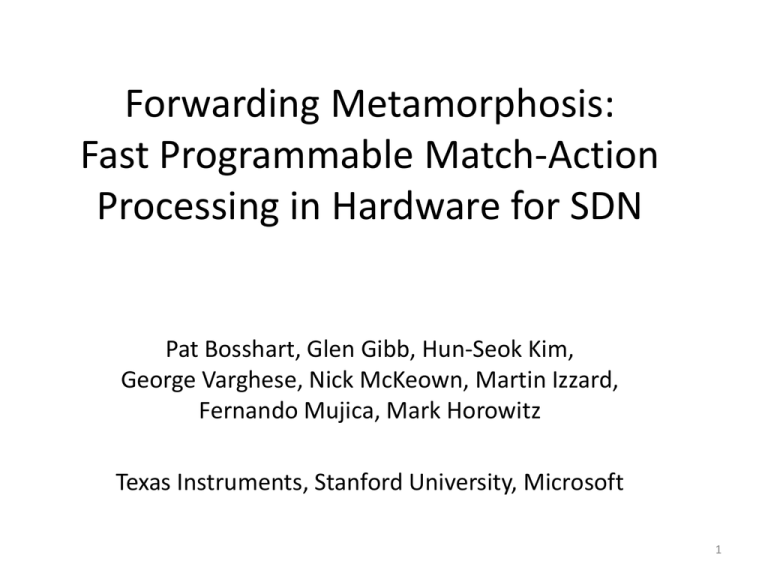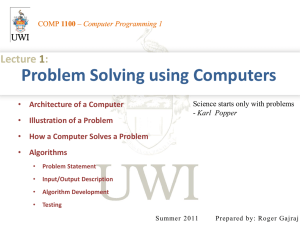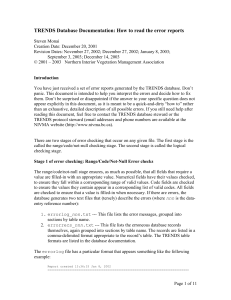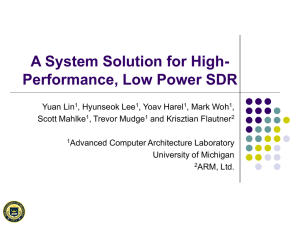Forwarding Metamorphosis: Fast Programmable Match
advertisement

Forwarding Metamorphosis: Fast Programmable Match-Action Processing in Hardware for SDN Pat Bosshart, Glen Gibb, Hun-Seok Kim, George Varghese, Nick McKeown, Martin Izzard, Fernando Mujica, Mark Horowitz Texas Instruments, Stanford University, Microsoft 1 Outline • • • • Conventional switch chips are inflexible SDN demands flexibility…sounds expensive… How do we do it: The RMT switch model Flexibility costs less than 15% 2 Fixed function switch Stage 2 Action: permit/deny X ACL Table Action: set L2D, dec TTL L3 Table L2 Table X L3 Stage Stage 1 ACL: 4k Ternary match ACL Stage Queues Out Deparser X X L2 Stage In Parser PBB Stage X Action: set L2D ????????? L2: 128k x 48 L3: 16k x 32 Exact match Longest prefix match Stage 3 Data 3 What if you need flexibility? • Flexibility to: – Trade one memory size for another – Add a new table – Add a new header field – Add a different action • SDN accentuates the need for flexibility – Gives programmatic control to control plane, expects to be able to use flexibility 4 What does SDN want? • Multiple stages of match-action – Flexible allocation • Flexible actions • Flexible header fields • No coincidence OpenFlow built this way… 5 What about Alternatives? Aren’t there other ways to get flexibility? • Software? 100x too slow, expensive • NPUs? 10x too slow, expensive • FPGAs? 10x too slow, expensive 6 What We Set Out To Learn • How do I design a flexible switch chip? • What does the flexibility cost? 7 What’s Hard about a Flexible Switch Chip? • • • • • • Big chip High frequency Wiring intensive Many crossbars Lots of TCAM Interaction between physical design and architecture • Good news? No need to read 7000 IETF RFC’s! 8 Outline • • • • Conventional switch chip are inflexible SDN demands flexibility…sounds expensive… How do we do it: The RMT switch model Flexibility costs less than 15% 9 The RMT Abstract Model • Parse graph • Table graph 10 Arbitrary Fields: The Parse Graph Packet: Ethernet TCP IPV4 Ethernet IPV4 IPV6 TCP UDP 11 Arbitrary Fields: The Parse Graph Packet: Ethernet IPV4 TCP Ethernet IPV4 TCP UDP 12 Arbitrary Fields: The Parse Graph Packet: Ethernet IPV4 RCP TCP Ethernet IPV4 RCP TCP UDP 13 Reconfigurable Match Tables: The Table Graph VLAN ETHERTYPE MAC FORWARD IPV4-DA IPV6-DA ACL RCP 14 Changes to Parse Graph and Table Graph ETHERTYPE Ethernet VLAN VLAN IPV6 IPV4 RCP IPV4-DA IPV6-DA L2S L2D RCP UDP TCP ACL Done MY-TABLE Parse Graph Table Graph 15 But the Parse Graph and Table Graph don’t show you how to build a switch 16 Stage 2 … Stage N Queues Deparser Stage 1 Match Action Stage Action Match Action Stage Action Match Action Stage Match Table Match Table Action Match Table In Programmable Parser Match/Action Forwarding Model Out Data 17 Performance vs Flexibility • • • • Multiprocessor: memory bottleneck Change to pipeline Fixed function chips specialize processors Flexible switch needs general purpose CPUs Memory L2 CPU Memory CPU Memory CPU L3 ACL 18 How We Did It • • • • Memory to CPU bottleneck Replicate CPUs More stages for finer granularity Higher CPU cost ok C P U Memory C P U C P U 19 RMT Logical to Physical Table Mapping Physical Stage 1 Physical Stage 2 Physical Stage n ETH 3 IPV4 VLAN ACL Table Graph SRAM HASH 640b Logical Table 1 Ethertype Action UDP Match Table TCP 5 IPV6 Action L2D Match Table 640b 2 VLAN Action IPV4 TCAM Match Table L2S IPV6 9 ACL 7 TCP 4 L2S 8 UDP Logical Table 6 L2D 20 Match result Header Out Field ALU Field Header In Action Processing Model Data Instruction 21 Modeled as Multiple VLIW CPUs per Stage ALU ALU ALU ALU ALU ALU ALU ALU ALU Match result VLIW Instructions 22 Our Switch Design • 64 x 10Gb ports – 960M packets/second – 1GHz pipeline • Programmable parser • 32 Match/action stages • Huge TCAM: 10x current chips • 64K TCAM words x 640b • SRAM hash tables for exact matches • 128K words x 640b • 224 action processors per stage • All OpenFlow statistics counters 23 Outline • • • • Conventional switch chip are inflexible SDN demands flexibility…sounds expensive… How do I do it: The RMT switch model Flexibility costs less than 15% 24 Cost of Configurability: Comparison with Conventional Switch • Many functions identical: I/O, data buffer, queueing… • Make extra functions optional: statistics • Memory dominates area – Compare memory area/bit and bit count • RMT must use memory bits efficiently to compete on cost • Techniques for flexibility – – – – – Match stage unit RAM configurability Ingress/egress resource sharing Table predication allows multiple tables per stage Match memory overhead reduction Match memory multi-word packing 25 Chip Comparison with Fixed Function Switches Area Section Area % of chip Extra Cost IO, buffer, queue, CPU, etc 37% 0.0% Match memory & logic 54.3% 8.0% VLIW action engine 7.4% 5.5% Parser + deparser 1.3% 0.7% Total extra area cost 14.2% Power Section Power % of chip Extra Cost I/O 26.0% 0.0% Memory leakage 43.7% 4.0% Logic leakage 7.3% 2.5% RAM active 2.7% 0.4% TCAM active 3.5% 0.0% Logic active 16.8% 5.5% Total extra power cost 12.4% 26 Conclusion • How do we design a flexible chip? – The RMT switch model – Bring processing close to the memories: • pipeline of many stages – Bring the processing to the wires: • 224 action CPUs per stage • How much does it cost? – 15% • Lots of the details how we designed this in 28nm CMOS are in the paper 27










